6 Examples of Automation in IT That Will Help You Get Ahead
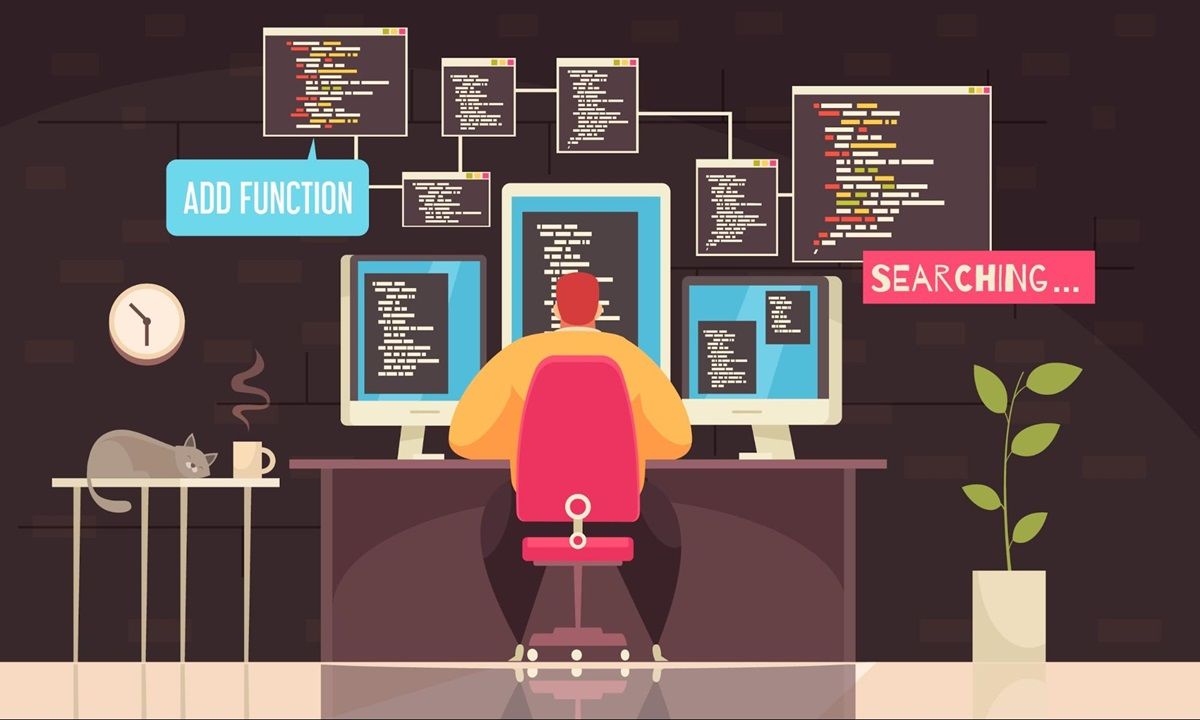
IT teams deal with endless repetitive tasks like tracking system logs, resetting passwords, and fixing server issues. These manual processes take time and often lead to human error.
That no longer has to be the case if you have intelligent automation. It uses software to handle routine tasks automatically, so your team can focus on bigger goals.
From managing infrastructure to improving customer support, automation helps businesses run faster and smarter.
In this article, you’ll learn the most common examples of automation in IT and how each one works.
Create your first automation today by signing up for free with Activepieces!
What Is Automation in IT?
Automation in IT means using software and automated systems to take over repetitive tasks that normally rely on people. Many IT departments still handle hundreds of small steps by hand every day, such as:
- Resetting passwords
- Checking servers
- Updating settings
- Logging tickets
Automation software now performs those actions automatically inside data centers and cloud systems without any human intervention. IT automation tools keep everything consistent, faster, and more reliable across large environments.
Every automated task begins with a trigger. That could be a new employee joining the company.
Once activated, the automation follows a sequence of actions such as creating accounts or granting system access. Several actions can connect to form automated workflows that complete an entire operation from start to finish.
Modern automation solutions use artificial intelligence along with automation technologies like machine learning (ML) and natural language processing (NLP) to detect irregular activity or predict failures before they affect users.
These systems also remove manual processes like inventory management and customer support, which brings the same consistency to IT operations that manufacturing automation brings to production lines.
Different Types of Automation Systems
Automation solutions include various types.
Fixed Automation
Fixed automation runs on a set sequence of mechanical actions that never changes once it’s installed. It focuses on automating routine tasks to improve operational efficiency and reduce per-unit costs.
Every part moves with precision, and every cycle produces the same result. Companies use it when they need to produce high volumes of the same product, like automotive frames or beverage cans.
The cost of building this kind of system is high, but the return comes from long-term output. A single production line can complete thousands of identical units per day with almost no downtime.
Each machine connects to the next through conveyor belts or transfer lines that keep the sequence running smoothly. Adjustments are rare since even a small design change can take weeks and a lot of money to retool.
Programmable Automation
Programmable automation gives you room to experiment with product designs and streamline processes, unlike fixed systems. Machines follow coded instructions stored in a computer, so you can load a new program when a different product needs to be made.
Every batch runs with unique settings, which helps you shift between product types without replacing the hardware. Computer numerical control (CNC) machines are a common example.
A technician can run a batch of steel brackets, switch programs, and start cutting aluminum parts in the same afternoon.
The setup still takes time to reset. You may need to replace tools or adjust fixtures between batches, which can slow production. However, the ability to reprogram equipment saves money compared to building a new system for each design.
Integrated Automation

Integrated automation connects machines, sensors, and software into a single system managed by one computer to streamline operations. Each step communicates with the next through a shared database.
CAD files, for instance, move directly into production, material handling robots load parts, and quality checks happen in real time. Sensors feed data back to the control center, which allows immediate adjustments that keep everything aligned.
When a system identifies a drop in output or detects wear, predictive maintenance tools flag it before it becomes a problem.
Many factories now operate with minimal staff under this setup. Orders enter the system, production begins automatically, and finished goods move to storage without human involvement.
Robotic Process Automation
Robotic process automation (RPA) replaces repetitive computer-based work with software bots. These bots follow predefined rules to move through digital systems the same way a person would, but faster and without mistakes.
Setting up RPA starts with identifying repetitive steps. Once recorded or scripted, the bot repeats them across multiple systems. Some run when triggered by users, while others operate automatically around the clock.
In finance, bots handle reconciliation. For human resources, they onboard new employees. By automating manual processes, companies cut down on time wasted on routine digital work and reduce errors that often slip through in large data tasks.
Process Automation
Process automation connects systems, data, and people so information moves smoothly from one stage to another. Each process runs through defined rules that tell software how to act when a trigger happens.
Typically, process automation involves workflow automation, RPA, and AI to form a single framework. Together, these process automation solutions reduce errors and speed up communication between departments.
Why IT Automation Is Essential for Modern Organizations
Modern companies depend on IT automation since it:
- Frees your employees from repetitive work so they can focus on projects that create value.
- Uses automated systems to perform tasks faster and with fewer mistakes.
- Handles data entry with precision, ensuring data accuracy and consistent reporting.
- Lowers operational costs by reducing manual effort and downtime.
- Improves speed and consistency across departments to enhance efficiency.
- Maintains quality assurance through constant checks and automated updates.
- Reduces burnout by cutting repetitive routines and raising job satisfaction.
- Adapts quickly to new workloads, technologies, or business changes.
6 Examples of Automation in IT You Can Use Today
Automation in IT covers many areas, and these automation examples show how your everyday tasks can run automatically.
1. Automated IT Ticket Management
Support teams get a lot of requests every day: password resets, app errors, and login problems. Automated IT ticket management uses software to handle these issues automatically.
When a user sends a request through chat or email, the system reads it, creates a ticket, and assigns it to the right person or team. It can also send updates to the user, like “Your issue is being fixed,” without anyone typing those messages.
Rules decide what happens to each ticket. If the issue is simple, like a password reset, the system can solve it on its own. Automation enables faster fixes and fewer delays as well because the software handles the steps that used to take minutes or hours.
Every action gets tracked, too, so you can see how many requests come in and how fast they’re solved. The data shows where problems keep happening and what needs more attention. This kind of automation replaces manual tasks and keeps requests organized.
Workflow Template From Activepieces: Customer Support Ticketing
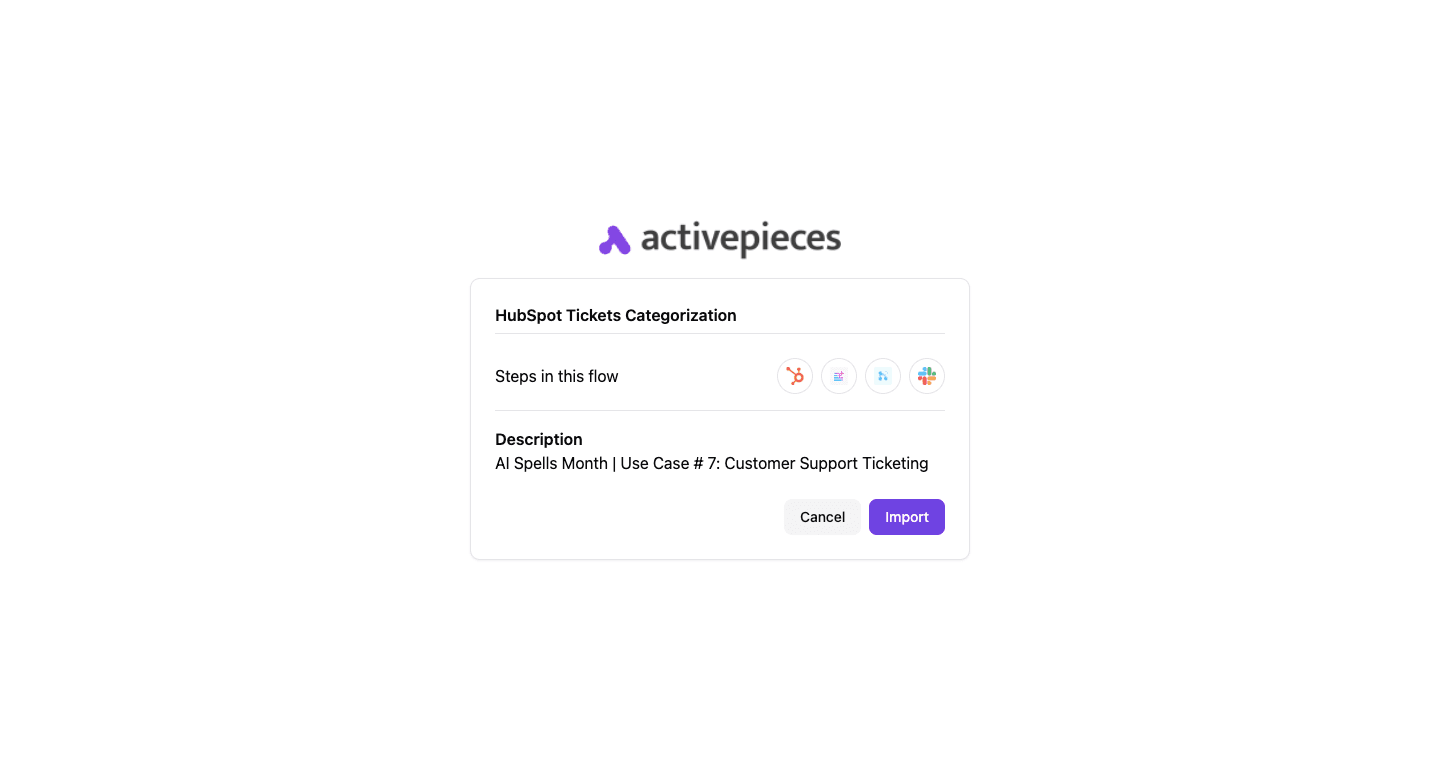
With Activepieces, your entire ticketing process runs automatically. It uses AI to rewrite unclear descriptions, classify requests by department, and alert the right team instantly through Slack. Each request reaches the right person without delay, which leads to faster and more accurate responses.
Components include:
- HubSpot integration (new ticket trigger): Starts the workflow when a new ticket is created.
- AI description rewriting: Simplifies and clarifies ticket descriptions automatically.
- AI ticket categorization: Sorts tickets by department or assigned team member.
- Router: Sends each ticket to the correct Slack channel or department.
- Slack integration (notification): Notifies teams immediately when a new ticket arrives.
Try this template: Customer Support Ticketing
2. User Provisioning and Deprovisioning
User provisioning means creating new accounts when someone joins a company. Deprovisioning, on the other hand, means removing access when someone leaves or changes roles.
Doing this by hand is slow and easy to mess up. Automation fixes that by connecting HR systems, IT tools, and apps into one seamless process. When HR adds a new employee, the system automatically creates accounts, gives permissions, and grants access to the right apps.
Configuration management tools keep everything set up the same way across systems. When an employee leaves, the system shuts down their accounts and removes their permissions right away. That helps stop unauthorized access and protects data.
3. Infrastructure Automation and Monitoring
Infrastructure automation manages all the servers, networks, and cloud systems that keep your company running. It uses code and scripts to build and control those systems automatically, so they work the same way every time.
That means new servers can be ready in minutes instead of hours. Everything happens with minimal human intervention, so your IT teams don’t spend their time doing the same setup work over and over.
Automation can also adjust how many resources are running. For example, if website traffic increases, extra servers can start automatically and shut down later to save money.
To make sure each server matches company standards, some companies use:
- Terraform
- Ansible
- Puppet
The same settings apply across every system, so nothing falls out of sync. Automating these steps supports larger strategic initiatives, such as faster app delivery and better system reliability.
4. Automated Backups and Data Security
Automated backups and data security protect information without depending on people to do the work.
Backup software copies files, databases, or even full systems on a set schedule, so everything is safe in case of damage or loss. These copies can go to:
- Cloud storage
- External drives
- Secure data centers
Data security runs alongside the backup process. Encryption locks the files while they move and while they’re stored. Access controls stop unauthorized users from opening them. That protects customer data and keeps your business compliant with privacy laws.
Many companies also include automation in their software development and network security plans, so protection stays active from start to finish.
Additionally, automation reduces the time required to complete complex tasks, such as restoring a full server. It further helps you build protection into your IT systems, reduce mistakes, and keep operations running even when something fails.
5. AI-Powered Incident Response
AI-powered incident response uses AI and ML to detect and fix problems in real time. Traditional systems depend on people to sort through alerts and logs, which slows down reaction times.
AI systems read data from networks, servers, and applications instantly. These systems isolate the issue, block the threat, and alert the right people when something seems wrong.
The technology works by learning what normal looks like inside the system. When data or traffic doesn’t match that pattern, AI triggers an automatic response. You can then focus on bigger threats as the software handles smaller ones.
Automation also leads to process improvements since every resolved issue helps the system learn. Over time, the software gets better at predicting and reacting to new kinds of attacks.
6. Customer Support Automation
Customer support automation helps you answer questions faster and more accurately.
Chatbots, self-service portals, and automated email systems handle common customer inquiries, like password resets or order updates. That frees human agents to handle tougher cases that need empathy or special knowledge.
Automated systems connect with customer relationship management (CRM) tools to store and use past interactions. It further improves your overall business operations by keeping response times short and messages consistent.
Reports from these systems show what customers ask about most and how quickly problems get solved. That data helps refine answers, train bots, and improve customer satisfaction scores.
Why Activepieces Leads the Future of Automation Software
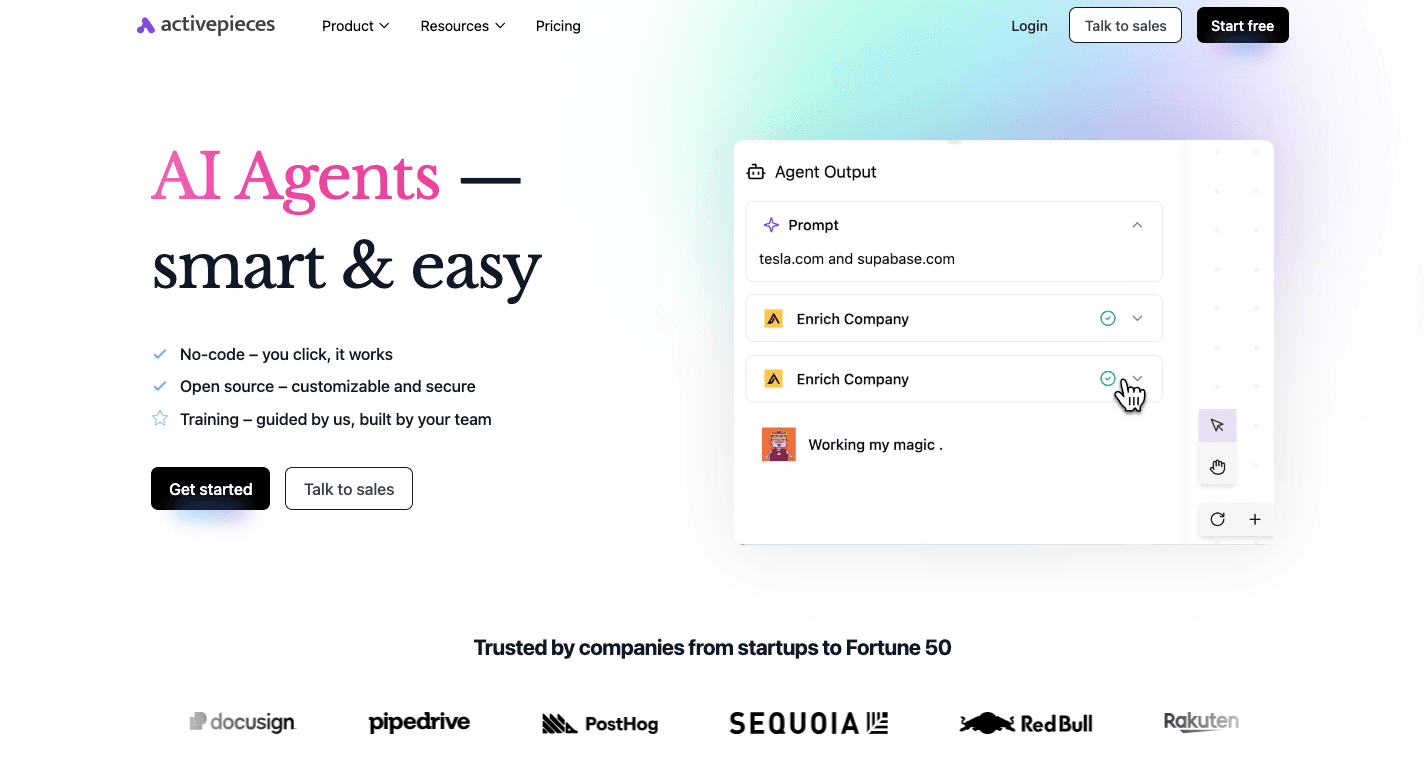
Activepieces is an open-source workflow automation tool created to make automation accessible to everyone. It combines advanced automation technologies with a simple interface, so you can connect apps, automate tasks, and manage complex workflows in one place.
Compared to many automation tools that require coding or costly plans, Activepieces lets anyone design automations without technical expertise. Organizations can use it to automate IT systems, automate data synchronization, and even provide AI-powered customer service.
Businesses of all sizes, from small startups to large enterprises, benefit from predictable pricing and community-driven growth. Activepieces redefines what automation software can do, proving that simplicity doesn’t have to mean limitations.
Key Features
- Open source ecosystem – Anyone can host and modify it freely.
- AI-ready automation – Uses built-in AI tools to rewrite data, make predictions, and power workflows.
- Human-in-the-loop controls – Let you delay or approve steps when needed for sensitive processes.
- No-code builder – Drag-and-drop builder that simplifies workflow creation for non-technical users.
- Enterprise-level security – Offers self-hosted options and network isolation for enhanced security.
- Custom pieces – Each integration, written in TypeScript, can be fully customized for unique business needs.
- Collaboration for teams – Allows sales teams and marketing teams to build shared automations that align with goals.
- Real-time monitoring – Tracks flow runs, performance, and error logs to maintain reliability.
Integrations
Activepieces offers 446 pre-built integrations, called pieces. These integrations connect to apps across marketing, productivity, AI, finance, and business intelligence. The library continues to expand every week because of community contributions and ongoing development.
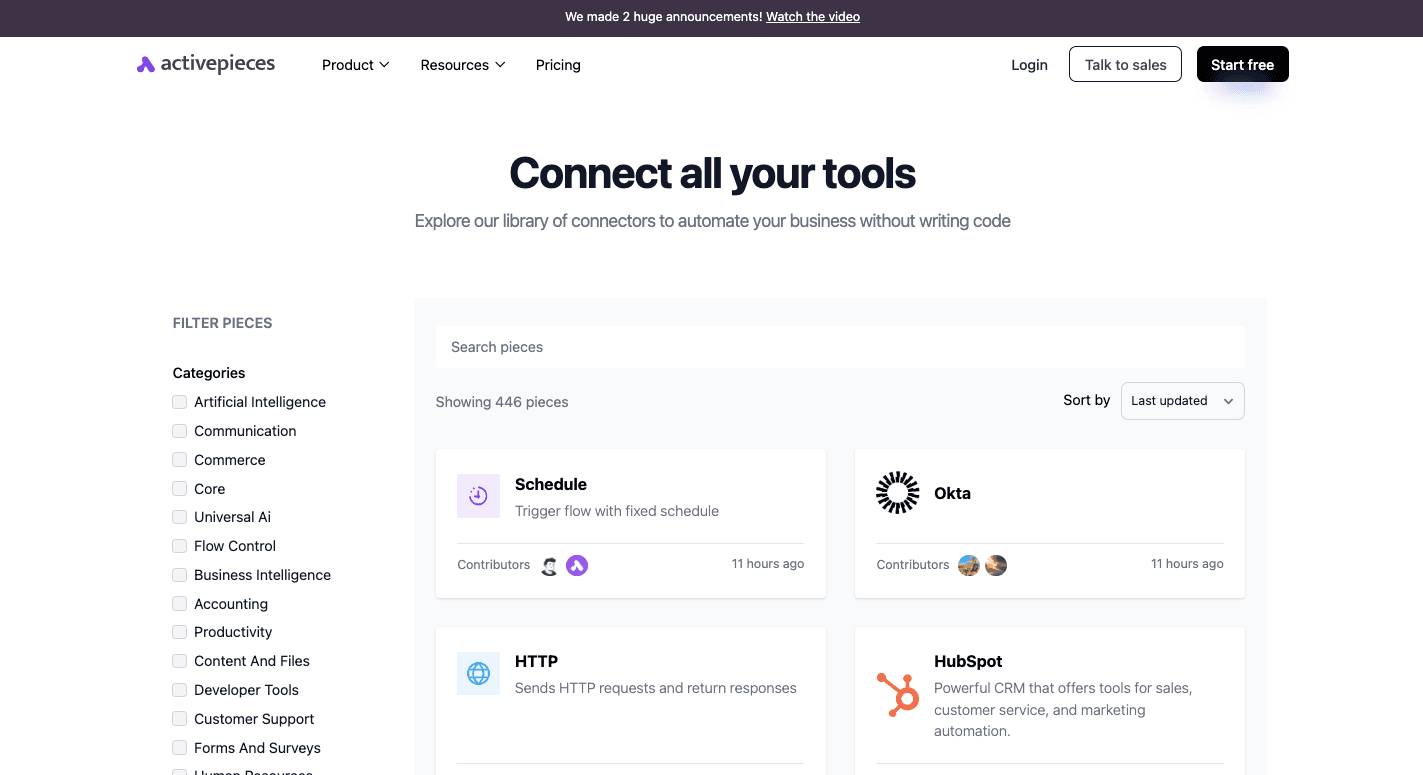
Some key data integration categories include:
- OpenAI
- Gemini
- ElevenLabs
- ClickUp
- Microsoft Excel 365
- Zoho CRM
- Zoho Desk
- Microsoft Dynamics CRM
- HTTP
Each integration helps you connect multiple systems in one flow. Whether you need to automate repetitive tasks, sync data across platforms, or build AI-driven automations, Activepieces has the tools to make it happen.
Use Cases
Activepieces can simplify work across industries and teams. It supports IT automation, marketing automation, and business process improvements.
For instance, it can:
- Automate ticket creation, routing, and updates for faster resolutions
- Schedule posts, track campaign performance, and sync leads across systems
- Connect CRMs, follow up with leads automatically, and track responses in real time
- Automate document updates, file transfers, and approval processes
- Manage infrastructure automation, backups, and data synchronization securely
These use cases show how Activepieces turns your routine work into fully automated processes that save time for high-value tasks.
Try Activepieces today and start automating your tasks without writing a single line of code!
Eliminate Human Error in IT Workflows Today With Activepieces
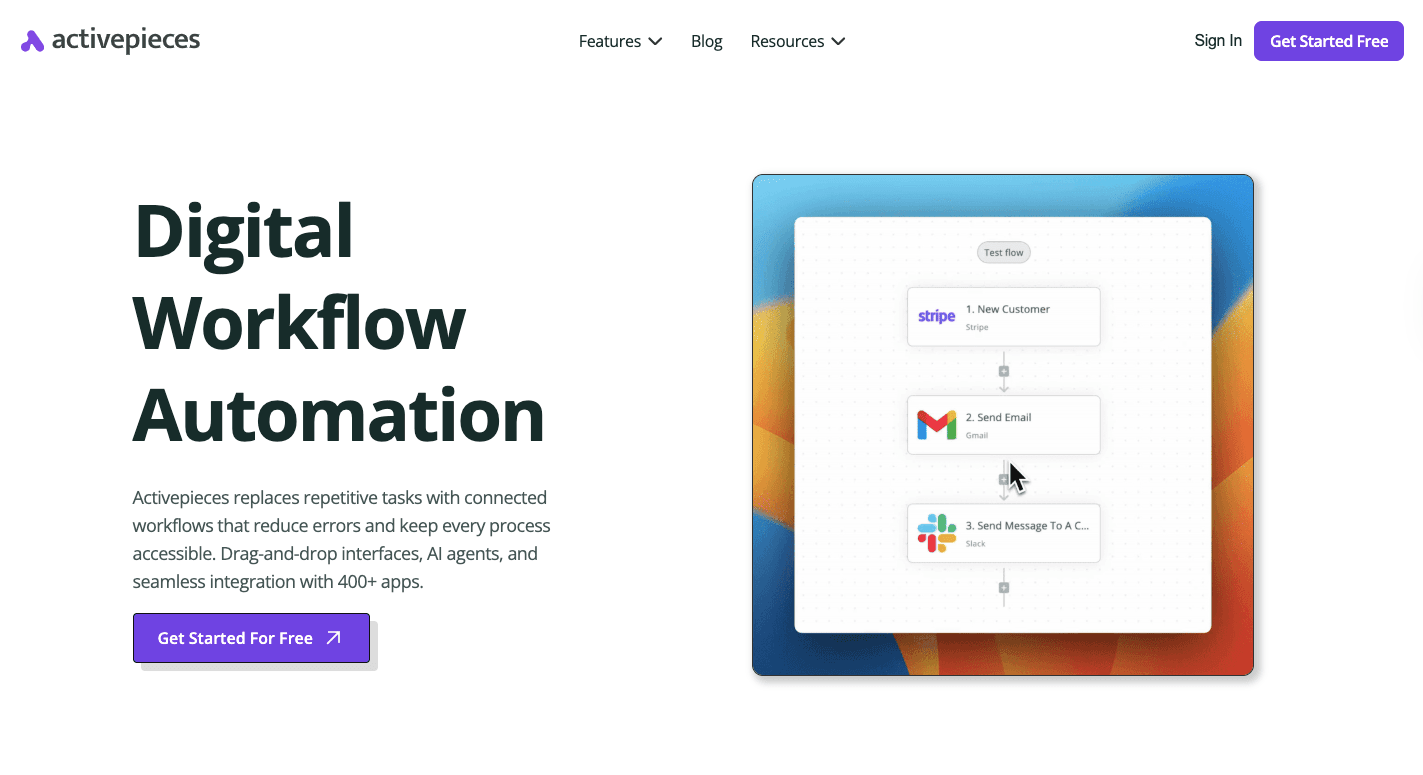
Activepieces helps IT teams remove manual work and reduce mistakes across daily operations. You can connect apps, automate workflows, and handle repetitive tasks without coding.
Developers can write and customize pieces in TypeScript for advanced workflows, while non-technical users can drag and drop actions in the no-code builder.
Everything happens in one space, from building IT automations to connecting customer systems or handling AI-driven tasks.
There are also AI-ready features, which give you the power to build smart automations that detect problems, reroute data, or notify the right team automatically.
Enterprise users can deploy it securely with self-hosted options that protect sensitive information and maintain complete control.
By automating workflows with Activepieces, your IT teams save hours of manual effort and reduce the risk of human error. From server updates to data synchronization, it’s the easiest way to run clean, reliable, and error-free operations at scale.
Discuss your automation strategy with sales and see how Activepieces helps you grow!
FAQs About Examples of Automation in IT
What is an example of automation in IT?
An example of automation in IT is using software to automatically manage server updates, monitor performance, and fix issues before they cause downtime.
This kind of automation supports supply chain management, predictive maintenance, and other core operations, improving efficiency and reducing errors caused by tedious tasks.
What is automation in the IT industry?
Automation in the IT industry means using software and systems to handle repetitive digital work such as data management, network monitoring, and user provisioning.
It helps you focus on complex tasks like risk assessment and business rules while improving the accuracy and speed of processes across IT operations.
What are the four types of automation?
The four types of automation are fixed automation, programmable automation, integrated automation, and robotic process automation. Each type supports different levels of control and flexibility in IT and manufacturing process systems.
What is an example of an automated information system?
An automated information system could be a data platform that collects, stores, and analyzes historical data from servers to predict performance issues. It runs routine updates and notifications automatically without human input, which keeps systems consistent and secure.
What is the role of business process automation in IT?
Business process automation in IT connects applications and workflows to replace manual steps with automated ones. It improves speed, lowers costs, and keeps information consistent across systems used in financial services, customer support, and internal operations.


